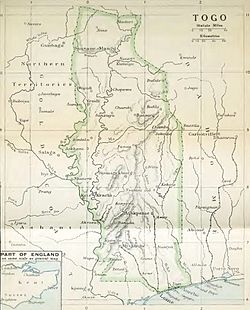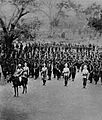Togoland campaign facts for kids
Quick facts for kids Togoland campaign |
|||||||||
|---|---|---|---|---|---|---|---|---|---|
| Part of the African theatre of World War I | |||||||||
 Togoland in 1914 |
|||||||||
|
|||||||||
| Belligerents | |||||||||
|
|||||||||
| Commanders and leaders | |||||||||
| Frederick Bryant Jean Maroix |
Hans von Doering Georg Pfähler † |
||||||||
| Units involved | |||||||||
| Gold Coast Regiment Tirailleurs Senegalais |
Paramilitary and police forces | ||||||||
| Strength | |||||||||
| British: 600 French: 500 |
693–1,500 (including reservists) |
||||||||
| Casualties and losses | |||||||||
| British: 83 French: c. 54 |
41 | ||||||||
The Togoland campaign was a short military event at the start of World War I. It happened between August 6 and August 26, 1914. During this time, French and British forces invaded Togoland, a German colony in West Africa. This invasion was the first part of the war in Africa.
German forces in Togoland tried to slow down the invaders. They moved away from the capital city, Lomé, and the coast. Their goal was to protect the Kamina wireless station. This station was very important. It allowed Germany to communicate with its colonies and ships far away. British and French troops came from nearby colonies. They advanced along roads and railways. Smaller groups also moved in from the north. The Germans fought back in small battles, like the Affair of Agbeluvoe and the Affair of Khra. However, they surrendered Togoland on August 26, 1914. Later, in 1916, Togoland was divided between Britain and France. In 1922, it became mandates under their control.
Contents
Understanding the Togoland Campaign
Togoland in 1914: A German Colony
In 1884, Germany took control of Togoland. It was a "protectorate," meaning Germany protected and governed it. The area was about the size of Ireland. In 1914, about one million people lived there. A mountain range ran through the country. It made travel between the coast and the inland areas difficult.
The southern part of Togoland was very developed. The Germans built three railway lines from Lomé, the capital city. They also built several roads. There was no big port, so ships used small boats to transfer goods. In 1905, a metal pier was built. It had a railway line to help move cargo directly onto trains.
German military forces in Togoland were small. There were no regular army units. Instead, there were about 693 "Polizeitruppen." These were paramilitary police, like a police force with military training. They were led by Captain Georg Pfähler. About 300 German colonists also had some military training.
Togoland was next to Allied territories. French Dahomey was to its north and east. The British Gold Coast was to its west. The most important places were Lomé and the wireless station at Kamina. Kamina was about 100 kilometers (60 miles) inland. It was connected to the coast by road and rail. The Kamina station was finished in June 1914. It was a key communication point for Germany. It linked Germany to its colonies, its navy, and South America. The British wanted to stop Germany from using it to plan attacks on ships.
British Gold Coast: Preparing for War
Sir Hugh Clifford was the Governor of the Gold Coast. Lieutenant-General Charles Macpherson Dobell was the commander of the Royal West African Frontier Force (WAFF). Both were away in July 1914. William Charles Fleming Robertson was the acting-Governor. Captain Frederick Bryant was the acting-commander of the Gold Coast Regiment.
The Gold Coast Regiment had about 1,595 soldiers. They also had 124 carriers and 330 reservists. Reservists are people who are not active soldiers but can be called up if needed. There were also "Volunteer Corps" and police officers. The British had a plan for war against the Germans in Togoland. They thought the Germans could only raid their borders. The plan included an attack across Lake Volta into northern Togoland. Then, they would push south.
On July 29, 1914, a telegram arrived. It ordered the Gold Coast to prepare for war. Captain Bryant decided to change the plan. He knew the Kamina wireless station was important. So, he moved his troops to the southern border with Togoland. He also prepared forces to move by sea to Lomé.
Starting the Invasion
Allies Prepare to Attack
On August 5, 1914, Britain declared war on Germany. The Allies quickly cut Germany's underwater communication cables. This left the Kamina radio station as Germany's only link to the outside world.
The acting-Governor of Togoland, Doering, sent a message to the British. He suggested that Togoland stay neutral. This meant it would not take part in the war. He referred to old agreements that said colonies in the Congo Basin should be neutral. Doering also said that the colonies depended on each other for trade. However, the British government refused his offer on August 6.
Captain Bryant, without waiting for orders, sent a message to Doering. He demanded that Togoland surrender within 24 hours. The next morning, the British heard a German wireless message. Doering was pulling his forces back to Kamina. He would surrender Lomé if attacked. The French in Dahomey also received a similar offer of neutrality. They thought it was a declaration of war and decided to invade.
Capturing Lomé: The First Steps
On August 6, French police took control of customs posts near Athiémè. The next day, Major Jean Maroix, the French commander, ordered his troops to capture Agbanake and Aného. They faced no resistance. Togolese civilians even helped by burning down a German government building.
The Germans, about 460 colonists and Askari (local soldiers), retreated inland. They called up more reservists as they moved north. The French began repairing the railway line. They advanced towards Porto Seguro and Togo. They stopped when they learned that Lomé had already surrendered to the British.
The British invasion started on August 7. British messengers returned to Lomé. They found that the Germans had left for Kamina. They had given a local German official, Rudolf Clausnitzer, permission to surrender Lomé. This was to prevent the British navy from bombing the city. On August 8, the British messengers took control of 14 British soldiers and police. They raised the British flag.
On August 9, more British troops arrived. They had marched 50 miles in very hot weather. Captain Bryant decided to move the main force by sea. They boarded a ship called the Elele on August 10. Three other companies were sent to Kete Krachi. They would start a land attack towards Kamina from there.
The Elele arrived off Lomé on August 12. The troops landed through the ocean waves. The British and French planned a combined attack towards Atakpamé. French forces would come from Aného and Tchetti. A British column would advance from Kete Krachi. Small British forces in the north were put under French command. About 560 French cavalry troops were ordered to advance from Senegal and Niger.
Moving Towards Kamina
Skirmish at Bafilo
On August 13, a small fight happened at Bafilo. It was between French troops and German Polizeitruppen in north-east Togoland. The French had crossed the border a few days earlier. They met more resistance than expected and had to retreat.
British Advance from Lomé
After Lomé was captured, Captain Bryant was promoted. He became Lieutenant-Colonel and commander of all Allied forces. He landed at Lomé on August 12. His force included 558 soldiers, 2,084 carriers, police, and volunteers.
As they prepared to move north, Bryant heard that a German group had traveled south by train. This group had destroyed a small wireless transmitter and a railway bridge. Bryant sent troops to stop further attacks. By evening, his "I" Company reached Tsévié. Scouts reported that the area south of Agbeluvhoe was clear of German troops. The main force reached Tabligbo.
At 10:00 p.m., "I" Company began to move towards Agbeluvoe. The land was difficult, with bushland and swamps. This forced the Allies to stay on the railway and the main road. The road was in bad condition. It was hard for the different groups to communicate because of the tall grass and thick bushes.
On August 15, the main force moved from Tabligbo. Local people told Bryant that a German train had shot up the station at Tsévié. Later, the British advance guard met German troops near the Lili river. The Germans blew up the bridge and dug in on the other side.
The Affair of Agbeluvoe
The Germans' actions slowed down the British advance. Doering had sent two groups of 200 men by train to delay the Allies. "I" Company heard a train at 4:00 a.m. while near Ekuni. A small group was sent to cut off the train. The rest of "I" Company went to Agbeluvoe.
A local Togolese person guided the British to the railway. Lieutenant Collins and his men put stones and a heavy iron plate on the tracks. This was about 200 yards north of the Ekuni bridge. They then set up an ambush. One of the German trains, with 20 cars, was derailed by the obstacles. The other train was stopped by the rest of "I" Company at Agbeluvoe. Captain Pfähler, the German commander, was killed. About a quarter of the German force became casualties.
The Affair of Khra
Even after the small fight at Bafilo and the Agbeluvoe incident, the Allies did not face much resistance. The last natural barrier before Kamina was the Khra River. Doering decided to make a stand here. The railway bridge over the river was destroyed. The areas around the river and village were mined.
On August 21, British scouts found 460 to 560 German Polizeitruppen. They were dug in on the north bank of the river. British and French forces gathered on the south bank. On August 22, Bryant ordered attacks on the German positions. The British were pushed back. They suffered 17 percent casualties. Lieutenant George Thompson became the first British officer killed in World War I.
Even though the Germans held their position, French troops were advancing from the north and east. A British column was also moving towards Kamina from the west. On the morning of August 23, the British found that the German trenches were empty. The Germans had retreated to the wireless station.
On the night of August 24/25, explosions were heard from Kamina. French and British forces arrived at Kamina on August 26. They found that the nine radio towers had been destroyed. The electrical equipment was also ruined. Doering and the remaining 200 Polizeitruppen surrendered Togoland to Bryant. The rest of the German force had deserted. The Allied troops found three Maxim machine-guns, 1,000 rifles, and about 320,000 rounds of ammunition.
What Happened Next
Casualties and Care
The British had 83 casualties during the campaign. The French had about 54, and the Germans had 41. Some soldiers and carriers on both sides also deserted. Lieutenant George Thompson was the first British officer to die in World War I. He is buried at Walhalla Cemetery near Atakpamé.
The German hospital in Lomé was taken over by the British. It was made bigger to care for 27 European and 54 local patients. Four German nurses and 27 other staff stayed behind. They continued to work under a British doctor. During the campaign, 13 Europeans and 53 local people were admitted for sickness. Six Europeans and 45 local people were admitted with wounds. One wounded person died. Field hospitals were set up along the supply routes. Wounded soldiers were quickly moved from Khra by an ambulance train. Wounded and sick prisoners of war were treated on a ship by a German medical officer.
Images for kids





